Malaysia: Visiting Wild Orangutan in Borneo
Visiting the Orangutan in Kuching for less than US$5
Using Kuching as your base in Sarawak, will give you the chance of meeting lots of wildlife. We spent a week based in Kuching and ventured out into the nearby jungles to witness first hand some of the exciting and interesting creatures that have inhabited this part of the world long before us humans arrived.
The best bit about these trips from Kuching is that you really don’t have to pay a tour company a lot of money to get you there to witness the natural world. You can do them all yourself with the aid of some pretty cheap Malaysian local transport and very reasonable entrance fees to the national parks, conservation centres and animal sanctuaries; all within a few kilometers of Kuching. We encountered loads of wildlife on our trip to Bako National Park, more of that though in a later blog post, but for now here is how to get to see the Orangutans in the wild for less than US $5. You can do this tour with one of the many travel tour operators, but you will be charged anything from US$20-30 . The choice is yours.
How to get to Semenggoh Orangutan Centre by local bus?
Using public transport from Kuching town centre, you can take the local bus K6 from the bus station (Bus Station Number 2). This is located near the market at the end of Jalan Mosque (Mosque Street). The buses are not too frequent, but the timings are lined up with the opening hours of the Semenggoh park (open from 8am – 11am and 2pm – 4pm with the feeding times at 9am and 3pm). If you are visiting for the afternoon session you need to catch the 1:15pm bus. The return fare for the 45 minute journey will cost you 5 MYR ($1.50)
If you want to go for the morning session, you need to set your alarms early and be at the station for the 7:15am bus which will get you to the park just as it is opening at 8am. Apparently, your chances of seeing these great apes are increased when visiting the park in the morning. The entrance fee is 10 MYR (US $3) for non-Malaysian visitors. From the entrance gates you have a 20 minute walk up into the main sanctuary where the park facilities and the feeding areas are located.
This will give you half an hour to wander around the small information exhibition about the orangutan conservation effort and have a quick peek at the rescued river crocodiles that are also kept here. Bizarrely, one of the crocodile cages also had a live chicken clucking about inside it which was making some pretty nervous sounds as the crocodile kept its beady eye on it. I guess that chicken may no longer be there when you get to the park!
The best way to see Orangutan from Kuching
Just before 9am the park rangers will give you a safety briefing about the orang utan feeding area and what to do if one takes an unhealthy interest in you. The wardens explain about the park, that the orang utans live wild, some as semi wild animals whilst they are taught to fend for themselves. The conservation efforts and successes in protecting orangutan. Many of them have been rescued from captivity and reintroduced to their natural habitats over the last three decades of its operation. There are no fences or boundaries, the creatures live there and will decide whether or not to come down and avail themselves of the limited free food provided at the two feeding times each day. In fact an orang utan sighting is far from guaranteed and the rangers say that on some days many people leave disappointed having not glimpsed a single beast.
You should remember you are not visiting a zoo or a safari park safely cocooned in your car or minivan. You are visiting the orang-utans in their natural habitat, they mostly spend their time building their nightly nests high up in the trees and generally doing what these creatures do in the wild; which is keep themselves to themselves forage and gather enough food to keep themselves alive.
One of the rangers spotted a mother and baby orangutan high up in the trees near the walkway down to the park and spent about twenty minutes calling out to them both to encourage them to come and get some of the free fruit he had on offer for breakfast that morning, They took their time swinging down from the trees and eventually they both made their way to us much to the delight of myself and the other visitors.
It was then time to get into the main feeding area deeper inside the jungle from the visitor centre. We had a small delay as some of the orangutans were blocking the path towards the area, but eventually we made it down the five minute walk to the viewing area. Here there is a platform where the morning food is laid out for the apes. When we arrived there were already three of them swinging their way down to the treats. They hung around, quite literally, feeding on the pineapple, mangoes and bananas for around twenty minutes mostly eating, but sometimes interacting with each other before making their way off through the branches and trees. No doubt they would report back and tell their friends what cute humans had come to visit them that day.
Seeing them in this environment was quite magical, out of the 29 apes, we got the chance to see five of them during our visit. It was fascinating to see them getting on with their habits and having the privilege to watch them during our 3 hours there. The best bit for me was spotting them in the trees before they came down to feed and watching them make their way back from the feeding area, seeing them swing effortlessly high up above you (you need a long lens to catch this as the canopy is about 30-40M above you). The other highlight for me was looking into their eyes when they were closer, and you can see every single bit of the 96.5 % shared DNA that we have with them – its eerily spooky.
This has to be one of the best value trips I have ever been on and feel truly blessed to have been able to see these creatures this close in their natural habitat. Not too close though, as these wild animals are incredibly strong and territorial. If you come to Kuching do not miss a trip Semenggoh Orangutan Centre. If you get unlucky and don’t see the Orangutan on your first visit, make sure you go back the next day and try again – trust me it will be worth the effort.
If you like monkeys and apes, and we certainly do, check out our travel blog posts on the tarsier monkeys in the Philippines and snow monkeys in Japan some other great ‘in the wild’ experiences.

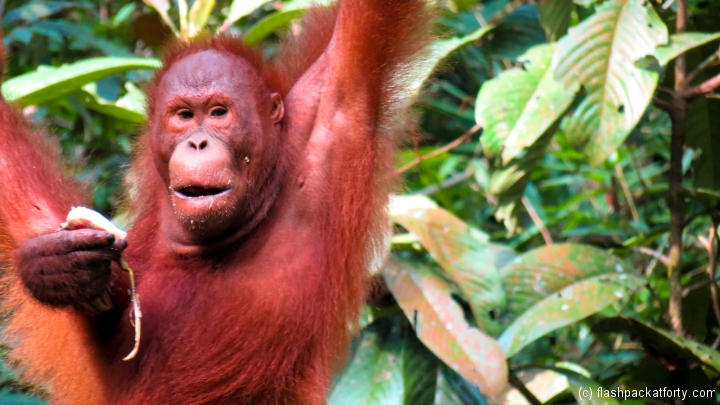
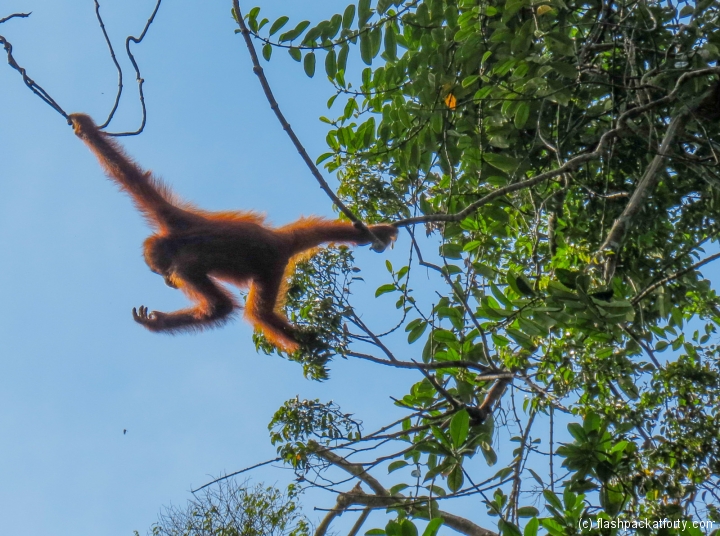

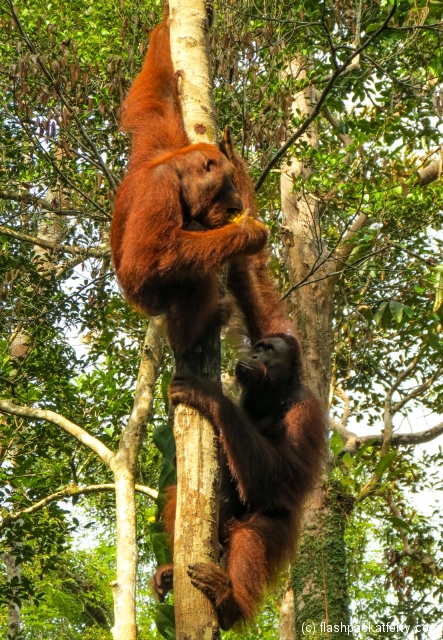

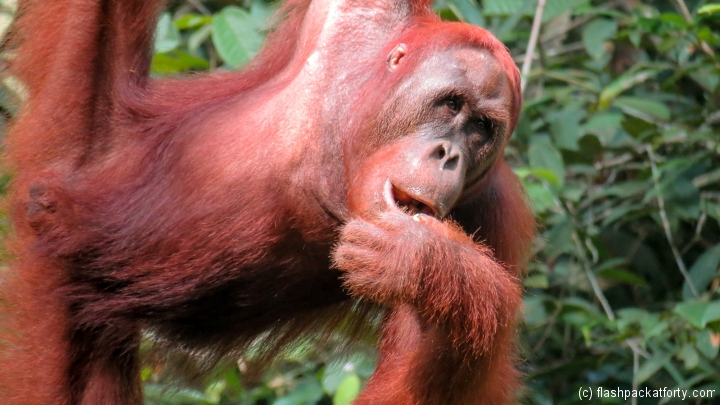
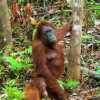



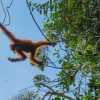


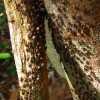
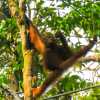
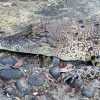
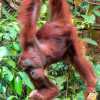
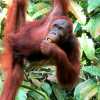

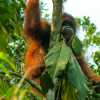
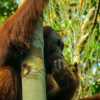

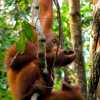
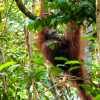
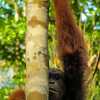
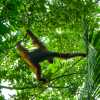
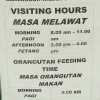

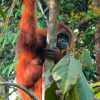
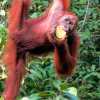

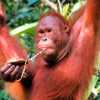

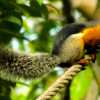












Such amazing animals – they look so wise. I would love to see them in their natural habitat, what a fantastic experience 🙂
It really was a special day Lizzie. Definitely one of the many highlights of travels around Malaysia and Borneo.